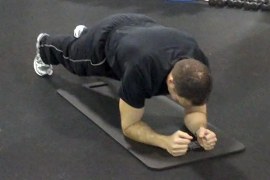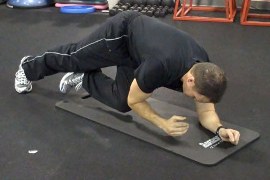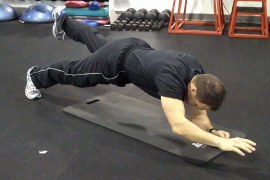 Brian continues his miniseries targeting the core with the swimmer plank, which is great for the core and posterior chain. Ensure, however, that your client has sufficient shoulder stability before undergoing this exercise!
Brian continues his miniseries targeting the core with the swimmer plank, which is great for the core and posterior chain. Ensure, however, that your client has sufficient shoulder stability before undergoing this exercise! See 'Related Resources' below for past Functionally Fits (including the core miniseries) and other exercises and training tips.
Execution
This is exercise an advanced dynamic progression of the traditional plank.

Begin in the traditional plank position.

Next, bring your right elbow to touch the left knee.

Pause and then extend the left leg and right arm fully while balancing in a two-point plank position.
Pause again in full extension, and repeat the sequence for 10-15 reps or a specified time. Repeat the process on the other side. Do one to three sets as desired.
Application
This exercise is a challenging way to activate the core and posterior chain while introducing three-dimensional movements around the spine. It is especially difficult with the added pauses and a deliberately slower cadence. As with the other exercises I have introduced in this series, it again demands excellent shoulder stability as well.
Precautions
For clientele with insufficient shoulder stability, marked upper-body weakness and an inability to master the plank, I would advise you to begin with a simpler, modified progression of this exercise to ensure safety and teach proper form:
- Plank on knees with alternate arm extensions
- Plank on knees with alternate leg extensions
- Full plank with opposite arm extensions
- Full plank with alternating knee pull-ins toward opposite elbow (no arm movement)
- Full plank with alternate opposite arm and leg extensions
- The full swimmer plank
To further increase the difficulty for your advanced clients, simply lengthen hold times to three to five seconds on the extensions, or add additional external load through a weighted vest. I would caution you against using unstable surfaces as the form will ultimately suffer, and the probability of potential injury and improper muscle substitution rises substantially.
Brian Schiff, PT, CSCS (www.brianschiff.com) is a licensed physical therapist, respected author and fitness professional. He became a Certified Strength and Conditioning Specialist (CSCS) in 1998. In 2000, he opened his own personal training and sport-specific conditioning facility, Fitness Edge, in Dublin, Ohio. Brian has presented at several professional conferences and seminars on injury prevention and sport-specific training.















